
Slinkachu ostavlja male (1 cm visoke) figurice ljudi po opasnim ulicama mnogih svjetskih gradova. Bića manja od hobita žive svoje plastične tragedije koje vjerojatno nećete ni primijetiti, no možda ugazite na njih žureći se prema nekoj vlastitoj - jednako sitnoj.
Nova vrsta umjetničke minijature.
www.flickr.com/photos/40878105@N00/
slinkachu.com/
Global Model Village: The International Street Art of Slinkachu
by Slinkachu
All of life is here in Global Model Village—from
the lowest low-rise views of Manhattan to the scorched flagstones of
Marrakech, from West London to the West Bank. A tiny mother and child
bustle through a dusty township in Cape Town, while a miniature
informant whispers in a telephone booth in Beijing. Thumb-size riot
police climb the Acropolis in Athens, while an inch-high woman
pole-dances around a lamppost in a Hong Kong red-light district.
Global Model Village collects
the international works of Slinkachu, the London-based artist who as
part of his “Little People Project” has been abandoning tiny model
people on the mean streets of the world since 2006. Documented through
photography, these little dramas of hope and tragedy, loneliness and
humor, somehow get to the heart of what it means to be human, to be
alone among millions of other people, all experiencing the melancholy
and magic of life in the big city.








Damn Kids
Stuttgart, Germany, 2011C-type print on Fuji Crystal Archive matte paper 80 x 120 cm (31 1/2 x 47 in). Also available in an edition of 15, 53 x 80 cm (21 x 31 1/2 in) and an edition of 3 on aluminium, 120 x 180 cm (47 1/4 x 80 in).
Downpour
London Bridge, London, 2010C-type print on Fuji Crystal Archive matte paper, 80 x 120 cm (31 1/2 x 47 in). Also available in an edition of 15, 53 x 80 cm (21 x 31 1/2 in) and an edition of 3 on aluminium, 120 x 180 cm (47 1/4 x 80 in).
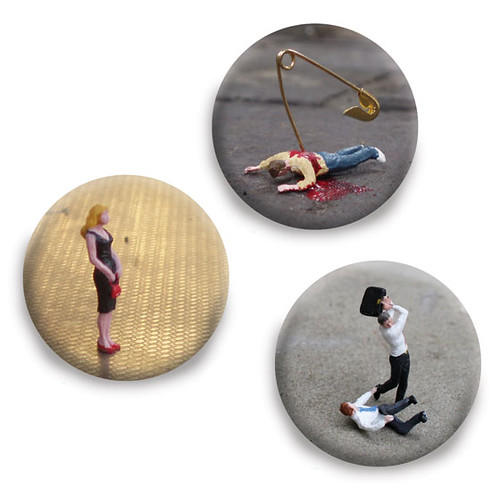
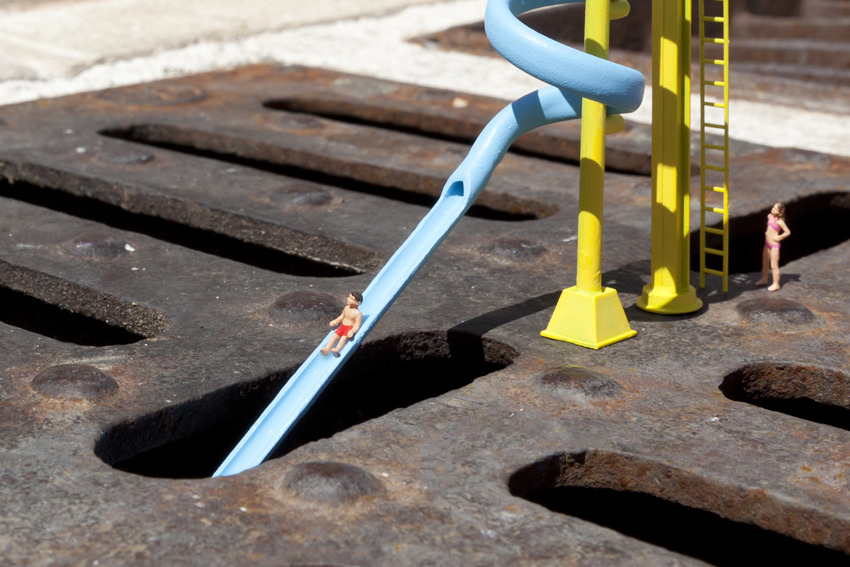
Global Model Village by Slinkachu
I had never heard of this guy before, and I’m thrilled I now have. Here’s a fantastic book about which I can be mercifully brief: you need to own this book because it is, ultimately, a book which’ll force you to see the world as ultimately stranger and more interesting, all the time, than you’re likely to without its nudging. Go to Slinkachu’s website. Poke around. That’s one of his photos, above. I can’t even believe how cool it is. I think the longest I’ve gone without cracking this book, just in sort of amusement and amazement, since getting it is three days. I dare you to go longer (and as a quick going-away note: it’s another fantastic release from Blue Rider Press, which, out of basically nowhere, has just come ass-kickingly into great view: the Neil Young bio, the Damien Echols bio, the Leanne Shapton swimming thing, this book, THE NEXT JEAN THOMPSON: these folks can’t miss).
http://corduroybooks.wordpress.com/
I had never heard of this guy before, and I’m thrilled I now have. Here’s a fantastic book about which I can be mercifully brief: you need to own this book because it is, ultimately, a book which’ll force you to see the world as ultimately stranger and more interesting, all the time, than you’re likely to without its nudging. Go to Slinkachu’s website. Poke around. That’s one of his photos, above. I can’t even believe how cool it is. I think the longest I’ve gone without cracking this book, just in sort of amusement and amazement, since getting it is three days. I dare you to go longer (and as a quick going-away note: it’s another fantastic release from Blue Rider Press, which, out of basically nowhere, has just come ass-kickingly into great view: the Neil Young bio, the Damien Echols bio, the Leanne Shapton swimming thing, this book, THE NEXT JEAN THOMPSON: these folks can’t miss).
http://corduroybooks.wordpress.com/
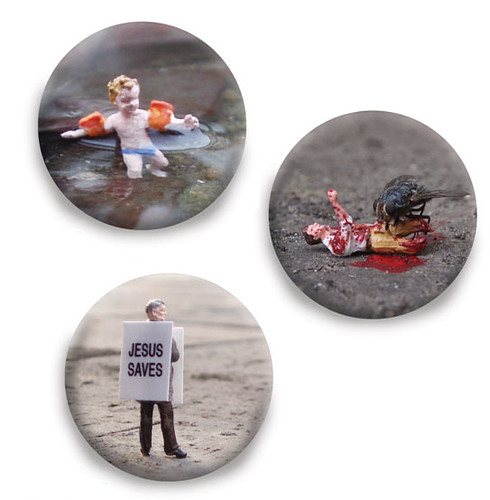

All Alone, one of Slinkachu's images from his latest collection, Global Model Village. Photograph: Slinkachu
Slinkachu started placing his figures, bought from a company that supplies model railway enthusiasts, around London, where he is based, in 2006. For his latest exhibition, Global Model Village, he has photographed his scenes in cities around the world including Cape Town, Doha, Berlin and New York. Tiny paddy-field workers toil in the puddles made by a Beijing manhole cover; a couple cower beneath a CCTV camera in Moscow. "What you think of as being very different types of places [around the world], people experience the same type of things, people understand it," he says. "I guess that's the overarching theme of this collection."
There is a joy in some of Slinkachu's images - the people riding a waterslide into a drain makes me happy to think about how minuscule people would use our world - but they usually tell stories of fear, loneliness and vulnerability. "It's the melancholy of life, especially city life," he says. Barely a centimetre high, the figures can produce a surprisingly magnified emotional reaction. "I've thought about it quite a lot over the years," he says. "I think it's the same thing you get with animals or babies - they bring out a nurturing side. What I try to do is reflect people's feelings, so they can put themselves into the characters."
Once Slinkachu has finished photographing his characters, he abandons them to the street. One piece – a man standing by a cash machine – survived for about three months. "I think he must have been just out of the way of the roadsweeper," he says. "Most of the time, I don't check. I like to leave them and not know what happens to them. I hope people find them, but at the same time part of the idea is that they might not. They might be completely lost." He smiles. "Or sat on."
Street art scales down: why Cordal and Slinkachu are masters of miniature
Slinkachu and Isaac Cordal's tiny figures speak of our insignificance in an uncaring universe – so watch your step
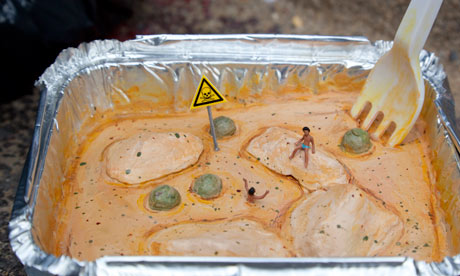
Slinkachu's Chicken Tikka Disasta. ‘Some of my locations are nasty. I once knelt on a hypodermic needle.’
Since 2006 these two London-based artists have been (independently) installing tiny dioramas in cities around the world, taking photographs – then leaving their work to be kicked or ignored or taken away. In one striking piece, Slinkachu constructed a scene of children bathing in a discarded chicken tikka takeaway in east London; in another, he positioned a group of riot police posing for holiday snaps in front of the Acropolis in Greece. Cordal put a row of suited men emerging from a grate at ankle height in Brussels, and a suicidal-looking figure on a high beam in Hackney. No individual sculpture by either is more than 5cm in height.
"I don't hang around to see what happens to the work," says Slinkachu, 31, a London-based former art director who prefers not to reveal his real name. "I don't want not to know. But there is a strange kind of buzz to abandoning your creations on the street."
Next month he will exhibit photographs of his past work, as well as installing some purpose-built new pieces at the Andipa Gallery in London for his show, Concrete Ocean.
Spanish-born Cordal's work, meanwhile, will be collected in his first solo book, Cement Eclipses, published by Carpet Bombing Culture in May.
Cordal, 36, is distinctly less enamoured than Slinkachu with the prospect of his miniature statues going walkies – "I don't leave them on the street for people to take; street art is for everyone, not just one person" – but is realistic about the likelihood of his art getting damaged or stolen. "Once art becomes part of the public domain, one of the possibilities is that the work disappears. Most of it disappears very fast. The main predators are cleaning services."
Slinkachu's work is free to take, he says, "if you can find it". No easy task. His sculptures, remodelled from cut-up train set figures, are usually less than 4cm tall and almost invisible from walking height.
"His people are often trodden underfoot," says Claire Mander of the Andipa Gallery. "But he's urging us to look more closely at our environment. The seeming glibness of the works cuts to the heart of the idea of being small, insignificant, a loser compared to more successful people."
Slinkachu says: "One of my pieces, a miniature cash machine with a figure withdrawing money, lasted three months, which I think is probably a record." He wasn't so lucky last year when he was commissioned to install his pygmy scenes around the grounds of Belsay Hall in Northumberland. All but one of the figures disappeared (including a man sitting at a picnic bench the size of a Lego brick, and a couple studying an upright cigarette butt as if it were an art installation). The stately home offered a "no grudge amnesty" for their return; the suspicion is that magpies got the lot.
Because of the ephemeral nature of the work, both Slinkachu and Cordal have made photography a key part of their method.
"At the beginning I used to take photographs only with the idea of documenting each installation," says Cordal. "Then I realised I could use photography to create more complex compositions." Slinkachu agrees. "I like to think of the photography as a form of reportage, like I'm recording a small drama. It all started as a hobby, a way to let off steam creatively, but then I became fascinated by the possibilities of telling stories with the figures through photography, and making people feel empathy for these little people."
In Cordal's case this is often achieved through cunning juxtaposition: his provocative Summer in London placed a man in swimming trunks (and gas mask) waist deep in an oily smear just outside a petrol station.
Slinkachu, meanwhile, toys with scale to play on ideas of loneliness and anonymity, especially in urban environments. The signature image of next month's exhibition depicts two figures adrift on what looks like a radiant desert island but is actually a tennis ball floating in a murky puddle in Wandsworth, a high-rise looming in the background.
"The feeling of being ignored and overlooked, of feeling small, is a universal one," says Slinkachu. "It is as easy for us to fall through cracks in the pavement in a big city as it is for the little people." What happened to the tennis ball island? Slinkachu isn't sure. "It was quite a visible one so I'm sure somebody spotted it. I like to think some kids found it and took it home."
Tiny artworks vanish from stately home
Amnesty offered to track down nine 'tiny people' created by London street artist Slinkachu, lost from Belsay Hall's gardens
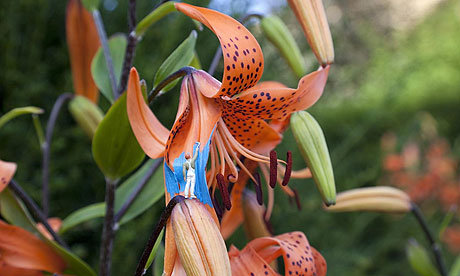
One of the Slinkachu figurines at Belsay Hall. Photograph: English Heritage/PA
Staff at a stately home are offering an amnesty to eagle-eyed
visitors who appear to have removed an entire Lilliput-sized art
exhibition from their mansion's grounds.
Nine "tiny people" made from resin by the London street artist Slinkachu have disappeared from the gardens at Belsay Hall, in Northumberland, where they were part of a "deliberately curious" summer show.
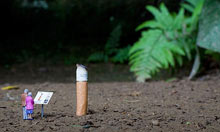 Photograph: English Heritage/PA
Designed to create an Alice-in-Wonderland effect of size differences
in the huge grounds, the 3-4cm figurines included a decorator painting
an orange tiger lily blue, an ice cream van, and a couple examining a
cigarette stub displayed as an art exhibit with its own explanatory
plaque.
Photograph: English Heritage/PA
Designed to create an Alice-in-Wonderland effect of size differences
in the huge grounds, the 3-4cm figurines included a decorator painting
an orange tiger lily blue, an ice cream van, and a couple examining a
cigarette stub displayed as an art exhibit with its own explanatory
plaque.
A tenth member of the hand-painted group is safely on a shelf in the office of Belsay's head gardener, Jo Hindhaugh, who tracked it down while weeding.
"The others have all gone," said Lynn Rylance, visitor manager for English Heritage at the 19th-century property. "The little people proved so popular that visitors who were lucky enough to spot the original versions seem to have taken them home with them as a memento."
The organisers of the Extraordinary Measures exhibition, which also includes contrastingly vast figures by Ron Mueck inside the hall, said some of the mini people might have met other predators. Jackdaws and magpies in particular have a habit of taking colourful objects to place in their nests. The exhibition's curator, Judith King, said others could have been blown away or eaten by rabbits.
Any souvenir-hunters need not feel guilty – rather, they might have the chance to become part of a follow-up exhibition. "Slinkachu makes these extraordinarily poetic works and leaves them to fend for themselves," King said. "He doesn't want them back, so much as to know where they have gone."
English Heritage said it would be delighted to find out whether the figures were now sitting on mantelpieces or car dashboards. A "no-grudge" amnesty is on offer for any information.
The exhibition continues until the end of the month.
Nine "tiny people" made from resin by the London street artist Slinkachu have disappeared from the gardens at Belsay Hall, in Northumberland, where they were part of a "deliberately curious" summer show.
 Photograph: English Heritage/PA
Designed to create an Alice-in-Wonderland effect of size differences
in the huge grounds, the 3-4cm figurines included a decorator painting
an orange tiger lily blue, an ice cream van, and a couple examining a
cigarette stub displayed as an art exhibit with its own explanatory
plaque.
Photograph: English Heritage/PA
Designed to create an Alice-in-Wonderland effect of size differences
in the huge grounds, the 3-4cm figurines included a decorator painting
an orange tiger lily blue, an ice cream van, and a couple examining a
cigarette stub displayed as an art exhibit with its own explanatory
plaque.A tenth member of the hand-painted group is safely on a shelf in the office of Belsay's head gardener, Jo Hindhaugh, who tracked it down while weeding.
"The others have all gone," said Lynn Rylance, visitor manager for English Heritage at the 19th-century property. "The little people proved so popular that visitors who were lucky enough to spot the original versions seem to have taken them home with them as a memento."
The organisers of the Extraordinary Measures exhibition, which also includes contrastingly vast figures by Ron Mueck inside the hall, said some of the mini people might have met other predators. Jackdaws and magpies in particular have a habit of taking colourful objects to place in their nests. The exhibition's curator, Judith King, said others could have been blown away or eaten by rabbits.
Any souvenir-hunters need not feel guilty – rather, they might have the chance to become part of a follow-up exhibition. "Slinkachu makes these extraordinarily poetic works and leaves them to fend for themselves," King said. "He doesn't want them back, so much as to know where they have gone."
English Heritage said it would be delighted to find out whether the figures were now sitting on mantelpieces or car dashboards. A "no-grudge" amnesty is on offer for any information.
The exhibition continues until the end of the month.
Little wonders
Street artist Slinkachu explains why he's driven to create witty scenes in miniature
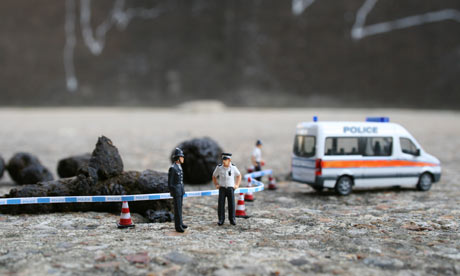
Zoom in ... little people in the city: street art of Slinkachu. Photograph: Slinkachu
I really like the idea that you can be trundling to work one day
and find some uncommissioned outdoor art, something on the floor or
pasted on a wall. I prefer work that isn't thrust in your face. There is
a high chance that my installations may never be found. My scenes are
made with tiny models and left hidden away on city streets, so they may
be lost. But that's what I like about them.
Alfresco art frees me up to do what I want. It started as a hobby, just to get my stuff out there, to entertain myself and hopefully others. I know that my work's going to get destroyed in the environment I pick for it, but I find it cathartic saying goodbye. I don't go back to check on the pieces; I prefer to leave them to their own devices.
Outdoor art always has an element of surprise because you have to search it out. People often recognise the locations on my website and try to find the work, but it will probably have been washed or kicked away by the time they get there. My main hope is that people will stumble across my art and not know anything about it in advance.
Street artists I admire include Space Invader (space-invaders.com), who makes space invader characters from mosaic tiles and puts them on buildings in London (Old Street and Brick Lane mainly). I also like the American artist Mark Jenkins, who's done a few things in London but which get destroyed quickly. He makes casts from his body out of Sellotape which he leaves in public spaces. They almost look like real people but their faces are hidden. He did an amazing one of a man leaning against a wall, and his head was disappearing into it.
I appreciate art that distorts your everyday experience. You can find examples all over if you look carefully.- little-people.blogspot.com
roughe.com
RT Crew's bold, colourful work can be spotted in Brighton and around London Bridge.
representlondon.com
Sickboy's "save the youth" slogans, skulls and globular buildings can be spotted in east London on Leonard St, Woodseer St and in Bristol on Ashley Road, where boards erected by the People's Republic of Stoke's Croft, a community arts group, to encourage locals to paint, have been commandeered by the graf community.
thesickboy.com
The Kids Are All Riot, a new free show by Goldie, runs 10-26 April at the Maverik Showroom, Redchurch St, Shoreditch, London and traces his graffiti work to date. He promoted the show by erecting fake estate agent letting signs proclaiming: "Let It Be".
The Cut Up Collective refashion billboards in mosaic format.
cutupcollective.com
Busk sprays disturbing scenes and funny dogs. Spot the mural outside London's Kilburn tube, at one time the largest piece ever commissioned in the UK. Also at Bristol's The Farm pub (Hopetown Road). thebusk.blogspot.com
• Compiled by Mark Jenkins, editor of ukstreetart.co.uk
Alfresco art frees me up to do what I want. It started as a hobby, just to get my stuff out there, to entertain myself and hopefully others. I know that my work's going to get destroyed in the environment I pick for it, but I find it cathartic saying goodbye. I don't go back to check on the pieces; I prefer to leave them to their own devices.
Outdoor art always has an element of surprise because you have to search it out. People often recognise the locations on my website and try to find the work, but it will probably have been washed or kicked away by the time they get there. My main hope is that people will stumble across my art and not know anything about it in advance.
Street artists I admire include Space Invader (space-invaders.com), who makes space invader characters from mosaic tiles and puts them on buildings in London (Old Street and Brick Lane mainly). I also like the American artist Mark Jenkins, who's done a few things in London but which get destroyed quickly. He makes casts from his body out of Sellotape which he leaves in public spaces. They almost look like real people but their faces are hidden. He did an amazing one of a man leaning against a wall, and his head was disappearing into it.
I appreciate art that distorts your everyday experience. You can find examples all over if you look carefully.- little-people.blogspot.com
Meet the underground graf community
Rough is a stalwart of the UK graf scene. See his lines and paint splatters at Cargo nightclub, London (83 Rivington St, cargo-london.com), the Kraken Opus Gallery wall (King St, Covent Garden), Wonderland hairdressers in Aberdeen (55 Skene St).roughe.com
RT Crew's bold, colourful work can be spotted in Brighton and around London Bridge.
representlondon.com
Sickboy's "save the youth" slogans, skulls and globular buildings can be spotted in east London on Leonard St, Woodseer St and in Bristol on Ashley Road, where boards erected by the People's Republic of Stoke's Croft, a community arts group, to encourage locals to paint, have been commandeered by the graf community.
thesickboy.com
The Kids Are All Riot, a new free show by Goldie, runs 10-26 April at the Maverik Showroom, Redchurch St, Shoreditch, London and traces his graffiti work to date. He promoted the show by erecting fake estate agent letting signs proclaiming: "Let It Be".
The Cut Up Collective refashion billboards in mosaic format.
cutupcollective.com
Busk sprays disturbing scenes and funny dogs. Spot the mural outside London's Kilburn tube, at one time the largest piece ever commissioned in the UK. Also at Bristol's The Farm pub (Hopetown Road). thebusk.blogspot.com
• Compiled by Mark Jenkins, editor of ukstreetart.co.uk
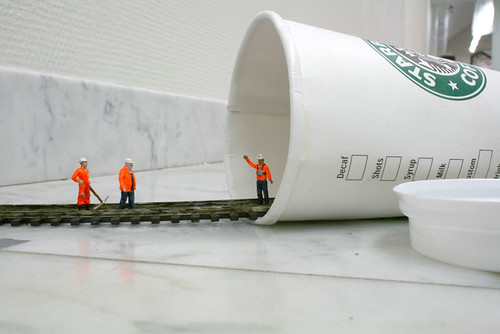



Nema komentara:
Objavi komentar